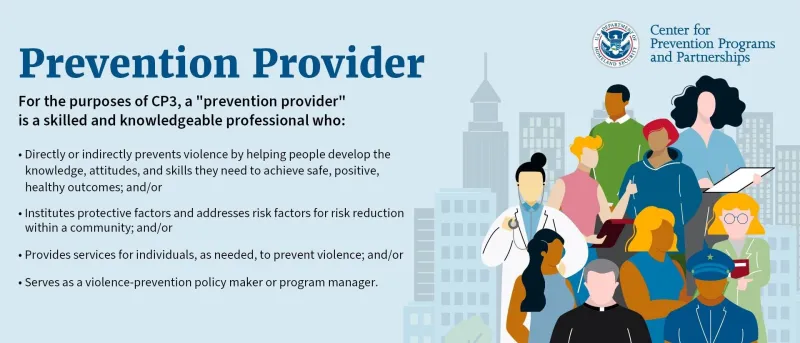Greetings from the Center for Prevention Programs and Partnerships (CP3).
The Homeland Security Act of 2002, drafted in the aftermath of the attacks of September 11, 2001, provides that the primary mission of the Department of Homeland Security (DHS) includes to “prevent terrorist attacks within the United States.” Like many of my colleagues at CP3, the terrible events of 9/11 ultimately brought me to terrorism prevention work in the office that largely inherited this solemn mission. This month, we in CP3 honor the lives lost and those who survived.
The tragic event in Winder, GA, serves as a painful reminder that terrorism is not the only form of targeted violence plaguing the country, and that our approach to targeted violence prevention must work to decrease the likelihood of grievance-based violence and hate-fueled violence as well. Some of our younger colleagues at CP3 have been inspired to serve for this very reason, and so we are proud to host CISA’s School Safety Task Force to lead a conversation at our upcoming virtual Prevention Forum on the 16th of September (details below), and to observe United Against Hate Week, Sept. 21 to 27.
DHS created CP3 to lead the Department’s efforts on targeted violence and terrorism prevention (TVTP). We recently published our “Approach to Targeted Violence and Terrorism Prevention,” to communicate our rationale for how CP3 strengthens our country’s ability to prevent targeted violence and terrorism nationwide through funding, education, training, evidence-based resources, increased public awareness, and strategic partnerships across every level of government, the private sector, and in local communities. Recently, I shared my personal thoughts and a description of CP3’s approach to prevention in an interview with the Combating Terrorism Center at West Point. I hope you'll take time to read the full interview in the CTC Sentinel.
It is partnerships with prevention providers that give us confidence and convince me it is time to turn our resources and energy toward prevention, not just responding to violent actors who have decided to commit such acts. Who are TVTP providers? Prevention providers include people already doing violence prevention work in their communities, including skilled professionals who directly or indirectly work to prevent suicide, violence against children, and intimate partner violence. They include individuals who help people develop the knowledge, attitudes, and skills to achieve safe, healthy, and empowered communities where violence is not an attractive way to advance an ideology, express a bias, or address a grievance.

Image Caption: Definition of Prevention Provider
One way CP3 works to enhance the national capacity for TVTP is to provide financial resources and technical assistance to grow the size and skill of the prevention provider community of practice. Just since June, CP3 has conducted more than 794 engagements with prevention providers, provided more than 20 trainings, and engaged with nearly 1,800 attendees in our virtual Prevention Forums. Additionally, site visits to the Prevention Resource Finder increased by more than 100% from June, due in part to our marketing efforts at national conferences. In a few weeks, we will announce grant awards totaling $18 million, under the TVTP Grant Program for fiscal year 2024.
Like other forms of violence, targeted violence and terrorism are preventable. I would encourage all violence prevention providers to join in the TVTP community of practice. This is so important to consider as we enter the back-to-school season. The touchpoints that our nation's prevention providers have with youth and young adults are critical to TVTP. Taking time to learn and understand the role you play is key, and I strongly encourage all prevention providers to attend our upcoming Prevention Forum Sept. 16 at 1 p.m.
In this issue of Prevention Connection, I invite you to learn more about CP3’s approach to international TVTP; the college and high school student winners of our experiential learning program, Invent2Prevent; and two of our TVTP grantees, Global Peace Foundation and the Polarization and Extremism Research and Innovation Lab (PERIL). Also, make sure you check out our three new Prevention Resources:
- Enhancing BTAM Capabilities Through a Public Health-Informed Approach
- Exploring the Use of Three-Digit Call Lines
- State TVTP Strategy Development + State Strategy Overview
Please let me know how the resources help you in your efforts to prevent violence. You can always reach me by emailing CP3@hq.dhs.gov.
Thank you for your continued engagement and partnership; it is essential if we are to prevent the next act of targeted violence.
Bill Braniff
